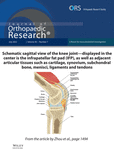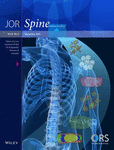Journal list menu
Export Citations
Download PDFs
ISSUE INFORMATION
Issue Information - Editorial Board and TOC
- Pages: 1471-1475
- First Published: 22 June 2022
REVIEWS
Infection
Current treatments for biofilm-associated periprosthetic joint infection and new potential strategies
- Pages: 1477-1491
- First Published: 19 April 2022
Osteoarthritis
Source and hub of inflammation: The infrapatellar fat pad and its interactions with articular tissues during knee osteoarthritis
- Pages: 1492-1504
- First Published: 21 April 2022
RESEARCH ARTICLES
Osteoarthritis
Shear strain and inflammation-induced fixed charge density loss in the knee joint cartilage following ACL injury and reconstruction: A computational study
- Pages: 1505-1522
- First Published: 17 September 2021
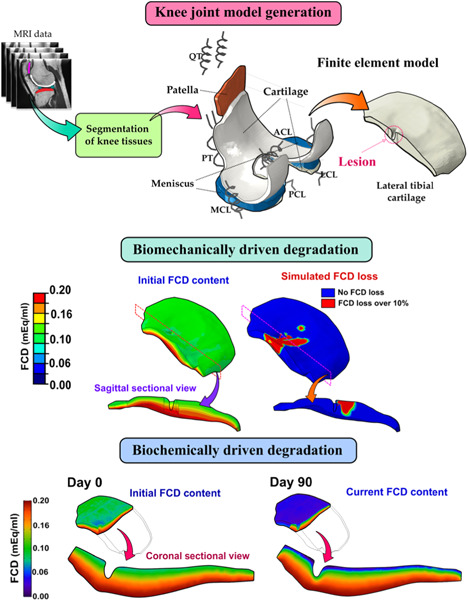
Biomechanical and biochemical degradation models were utilized to estimate fixed charge density (FCD) loss using a patient-specific finite element model of an anterior cruciate ligament reconstructed knee joint. Biomechanical degradation was based on the excessive maximum shear strains that may result in cell apoptosis, while biochemical degradation was driven by the diffusion of pro-inflammatory cytokines. The biomechanical model predicted substantial localized FCD loss near the lesion and on the medial areas of the lateral tibial cartilage. In turn, the biochemical model predicted FCD loss all around the lesion and also at intact areas.
A quantitative measurement of trapeziometacarpal joint pressure using a cadaveric model of lateral pinch
- Pages: 1523-1528
- First Published: 18 October 2021
Knee
Groove-deepening trochleoplasty reduces lateral patellar maltracking and increases patellofemoral contact pressures: Dynamic simulation
- Pages: 1529-1537
- First Published: 24 September 2021
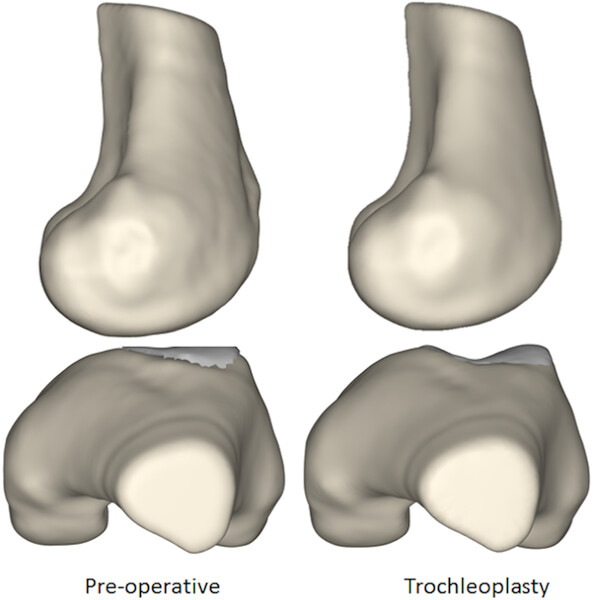
Multibody dynamic simulation of knee function was used to evaluate groove-deepening trochleoplasty to treat patellar dislocations. Compared to the preoperative condition, trochleoplasty significantly decreased lateral patellar tracking from full extension to 60° of knee flexion. The average contact area decreased by approximately 10% in mid-flexion, with a corresponding increase in the maximum contact pressure of 13%–23%. Decreased lateral patellar maltracking reduces the risk of patellar dislocations, but elevated patellofemoral contact pressures could contribute to long-term cartilage degradation.
Intraoperative knee kinematics measured by computer-assisted navigation and intraoperative ligament balance have the potential to predict postoperative knee kinematics
- Pages: 1538-1546
- First Published: 24 September 2021
Kinematics of bicruciate stabilized and cruciate retaining total knee arthroplasty
- Pages: 1547-1554
- First Published: 15 October 2021
Bone
Inflammatory cytokines associated with outcomes in orthopedic trauma patients independent of New Injury Severity score: A pilot prospective cohort study
- Pages: 1555-1562
- First Published: 02 November 2021
Mg2+-mediated autophagy-dependent polarization of macrophages mediates the osteogenesis of bone marrow stromal stem cells by interfering with macrophage-derived exosomes containing miR-381
- Pages: 1563-1576
- First Published: 02 November 2021
Relation between diameter of a lateral screw and pull-out strength in distal clavicle fracture in plates with different geometry: A cadaveric biomechanical study
- Pages: 1577-1583
- First Published: 18 October 2021
Tendon/Ligament
Phenotype stability, expansion potential, and senescence of embryonic tendon cells in vitro
- Pages: 1584-1592
- First Published: 24 September 2021
Pulsed electromagnetic field therapy alters early healing in a rat model of rotator cuff injury and repair: Potential mechanisms
- Pages: 1593-1603
- First Published: 17 October 2021
Investigation of multiple populations highlight VEGFA polymorphisms to modulate anterior cruciate ligament injury
- Pages: 1604-1612
- First Published: 18 October 2021
Age- and sex-specific differences in ACL and ACL bundle size during adolescent growth
- Pages: 1613-1620
- First Published: 02 November 2021
Muscle
Microenergy acoustic pulses promotes muscle regeneration through in situ activation of muscle stem cells
- Pages: 1621-1631
- First Published: 17 October 2021
Imaging
Compositional evaluation of lesion and parent bone in patients with juvenile osteochondritis dissecans of the knee using T2* mapping
- Pages: 1632-1644
- First Published: 12 October 2021
Development, construction, and validation of a thinner uniplanar calibration cage for radiostereometry
- Pages: 1645-1653
- First Published: 19 October 2021
Reliability and accuracy in radiographic measurements of musculoskeletal tumors
- Pages: 1654-1660
- First Published: 30 October 2021
Spine
The function of CD146 in human annulus fibrosus cells and mechanism of the regulation by TGF-β
- Pages: 1661-1671
- First Published: 18 October 2021
High fat diet causes inferior vertebral structure and function without disc degeneration in RAGE-KO mice
- Pages: 1672-1686
- First Published: 21 October 2021
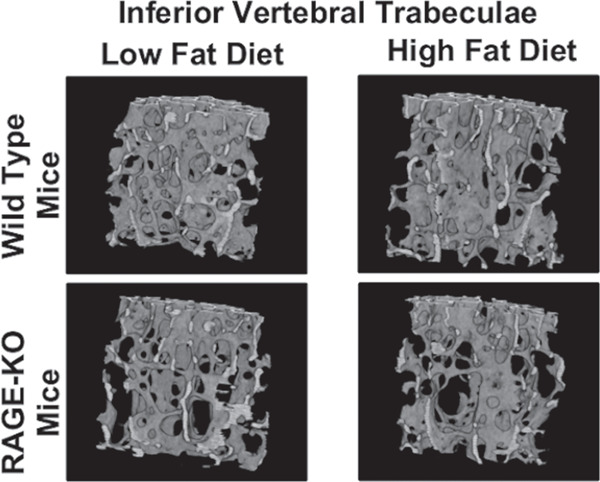
High fat (HF) diet led to obesity and inferior vertebral trabecular bone structure and function in mice of both sexes with greater effects in females. HF diet did not result in intervertebral disc degeneration in either sex but did cause inferior vertebral cortical bone structure in males. Systemic ablation of the receptor for advanced glycation endproducts (RAGE-KO) had few modifying effects. These early structural deficiencies may increase risk for spinal injury and degeneration with aging and additional stressors.
Anteroposterior shear stiffness of the upper thoracic spine at quasi-static and dynamic loading rates—An in vitro biomechanical study
- Pages: 1687-1694
- First Published: 20 October 2021
Shoulder
Thin patient-specific clavicle fracture fixation plates can mechanically outperform commercial plates: An in silico approach
- Pages: 1695-1706
- First Published: 19 October 2021
Quantitative SSM-based analysis of humeral head migration in rotator cuff tear arthropathy patients
- Pages: 1707-1714
- First Published: 19 October 2021




